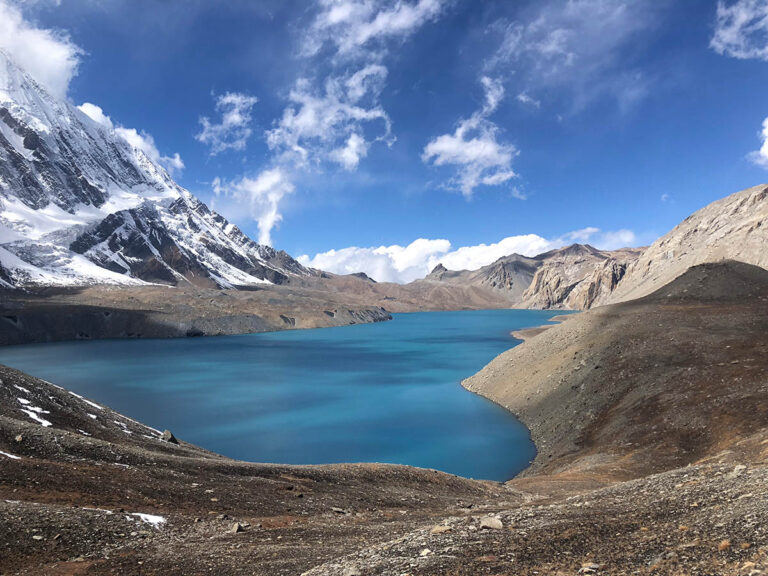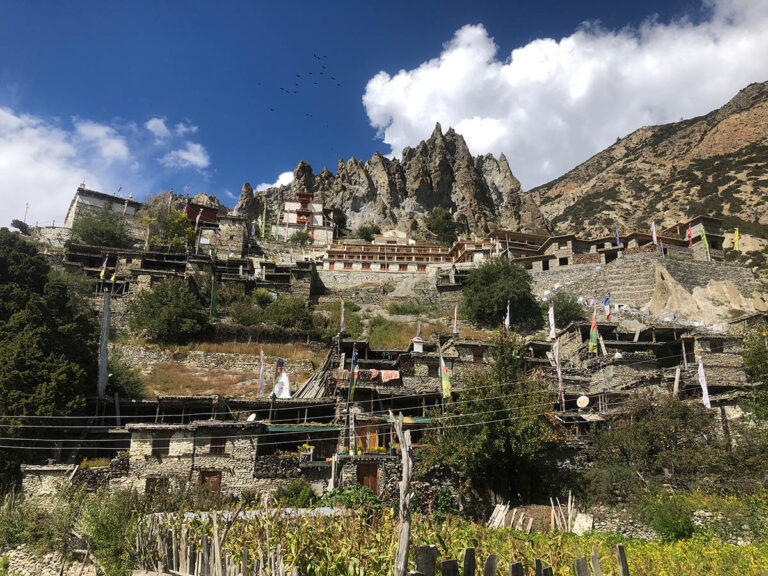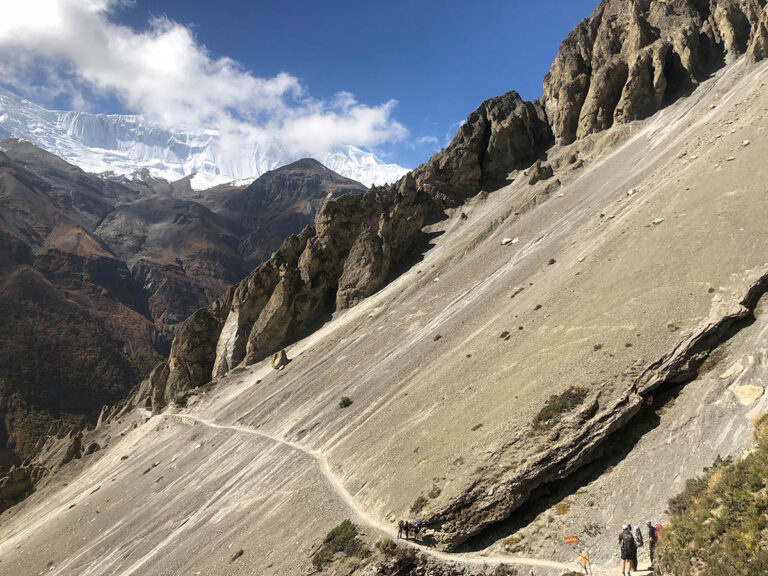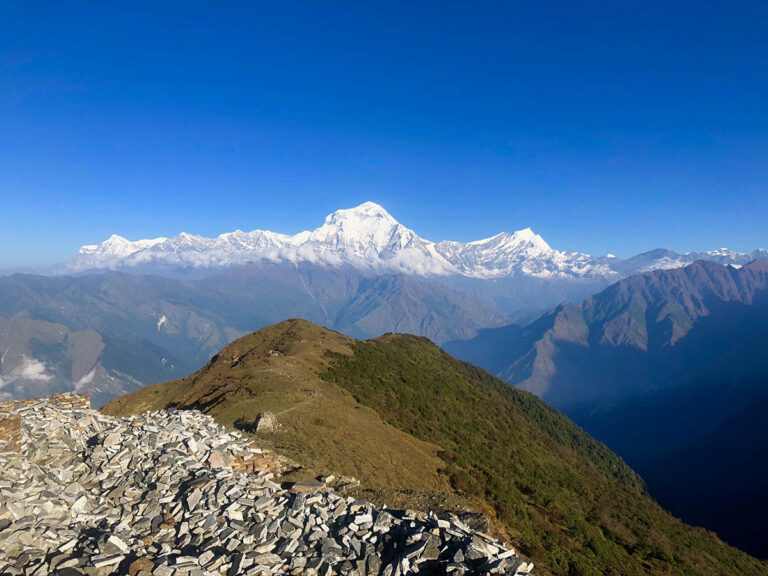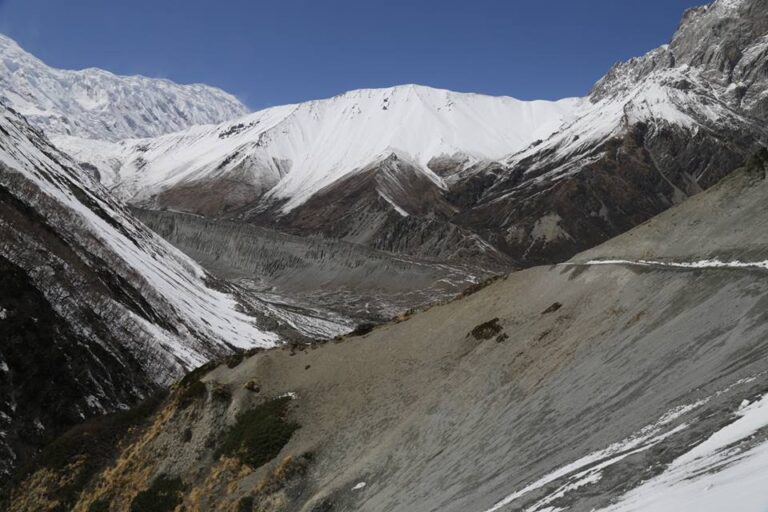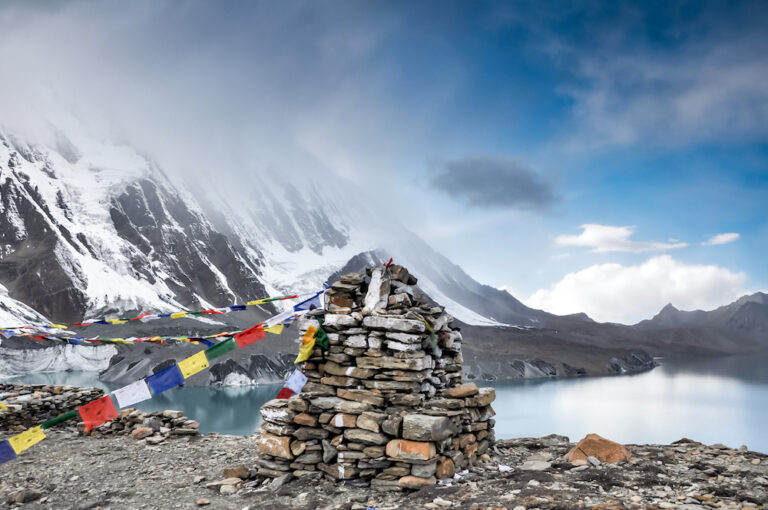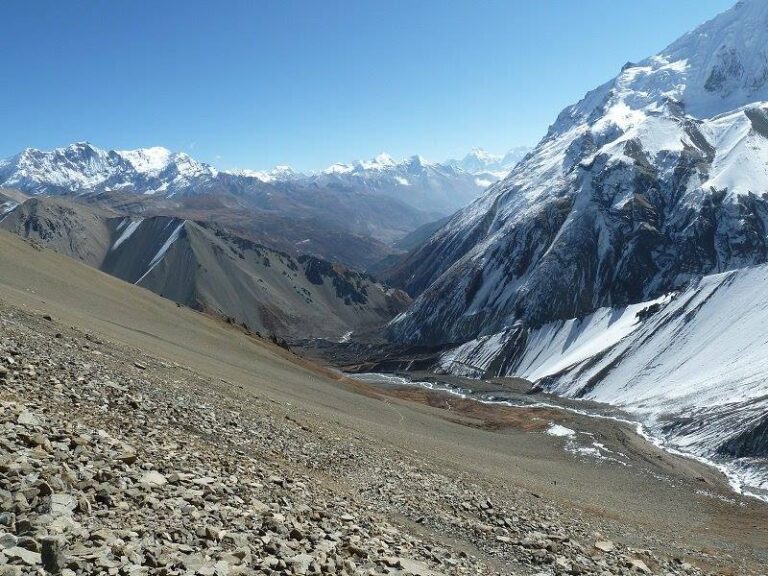Day 01-Drive to Besisahar and hike up to Bhulbhule village -Besisahar is 185 kilometers far from the Kathmandu city so we will drive an approximately 7 hours to get Besisahar. The highway leads us just bank of the Trisuli and Marshyandi River with the view of green landscapes, agricultural terraced and as well as far view of the Annapurna, Ganesh Himal and Manaslu mountain ranges. After Besisahar, we will walk on the road for 45 minutes then we will take alternative trail to get Bhulbhule village pass by the Bajhkhet and Simalchaur village that command us to see beautiful view of green landscapes, Marshyandi River valley and the spectacular view of Lamjung Himal.
Day 02-Trek to Ghermuphat (1130m.a.s.l) -5 hours walk –Begin of the trek we will walk an approximately 2 hours on the flat trail pass by small hamlets called lower Ngadi and upper Ngadi village. After half an hour walk from upper Ngadi village appear a trail junction and we will turn to the right hand side and climb up an approximately one hour to get Bahundanda village. After Bahundanda village, we will walk downhill trail for 15 minutes than rest of the trek to get Ghermuphat would be very pleasant walk due to flat trail. During the day, we will enjoy with the charms landscapes, waterfalls, terraced field and dozens of small villages, which are settled over the vertical land.
Day 03-Trek to Tall village (1700m.a.s.l) -6 hours walk -15 minutes downhill trail bring us to Shyange village where we can see a beautiful Shyange waterfalls over the small town called Shyange. After Shyange village we will walk on the road until Chyamche village pass by the Srichaur and Jagat village. Chyamche village offers to see beautiful Chyamche waterfalls, huge rocky hills and wild honeycombs, which are hanging over the cliff. After Chyamche village, we will turn to the right hand side and an approximately 10 minute’s walk downhill trail brig us to a suspension bridge, which is hanging over the Marshyandi River. From here, the trail gently ascends to the Saattale village and through the Bamboo forest that may takes an approximately 3 hours to get Tall village.
Day 04-Trek to Timang village (2400m.a.s.l) -6 hours walk -We will trek just bank of the Marshyandi River gorge pass by the beautiful villages called Siran Tall, Khotro, Bagarchhap and Danaque which are inhabitant by the Gurung and Tibetan people so along the trail we will see some Stupa, Mani walls with prayer wheals and as well as small monasteries in Bagarchhap and Danaque village. The trail from Tall to Danaque would be very pleasant and easy due to walk on the gradual trail. After Danaque village we will climb up through the Rhododendron forest stepping by the rocky path, which may takes an approximately two hours to get Timang village.
Day 05-Trek to Dhukur pokhari (3200m.a.s.l) -6 hours walk -We will have our breakfast with the stunning view of Manaslu to the southwards and Namun peak to the north side of the Timang village and we will head to Dhukur pokhari village pass by the Thanchowk, Koto, Chame, Talekhu and Bhratang villages which are inhabitant by the Tibetan people so along the trekking trail we will see dozens of Stupa, Mani walls, Monasteries and other Buddhist monuments. We will ascends gradually to get Dhukur pokhari village with the view of Rocky hills, Marshyandi River gorge, green forest and as well as magnificent view of Lamjung Himal, Manaslu, Pisang peak, Chulu peak and Annapurna two.
Day 06-Trek to Ngawal village (3660m.a.s.l) -5 hours walk -Today is one of the fabulous day of entire the Annapurna circuit or Tilicho Lake trek because today we going to see panoramic view of high mountains called Lamjung Himal, Annapurna II, Annapurna IV, Annapurna III, Gangapurna, Khangsar peak and Tilicho peak to the southwards of the Manang valley and East Chulu, center Chulu, West Chulu and Pisang peak to the northern side of the Manang valley. Begin of the trek we will walk one the flat trail to get Pisang village which is divided into the two parts as lower and upper Pisang .The upper trail is being popular than lower trail due to better mountains view and offers to explore beautiful monastery which is located just top of the upper Pisang village. After Pisang village we will walk an approximately 45 minutes on the flat trail and appear a beautiful Mani walls then the trail gently ascends and takes about four hours to get Ngawal village.
Day 07-Trek to Manang village (3500m.a.s.l)-5 hours walk –There are two trails to get Manang village as lower trail and trek via Julu village. The lower trail is shorter than via Julu village but still trek to Manang via Julu village would be joyful due to better view and less tourist traffic. An approximately half an hour walk bring us to a beautiful monastery then we will descends half an hours to get a ancient settlement of Tibetan people called Julu village where can be seen about 15 houses, stupa and some old Mani walls. After Julu village we will walk an approximately three hours on the flat trail to get Manang village pass by Mungji and Bhraka village that offers to explore some monasteries which are believe to be more than 600 years old.
Day 08 – Acclimatization day -4 hours climb up and 3 hours return back–There are many beautiful places around the Manang village known as Chungur viewpoint, Pranken Monastery, Milarepa cave and Ice-Lake but still sight trip to Ice-Lake is being very popular than others due to better view and to get well acclimatization. The Ice-Lake is located just northern side of the Manang village an elevation with 4600 meters and offers to see panoramic view of high mountains called Lamjung Himal, Annapurna II, Annapurna IV, Annapurna III, Gangapurna, Khangsar peak and Tilicho peak to the southwards of the Manang valley and East Chulu, center Chulu, West Chulu and Pisang peak to the northern side of the Manang valley.
Day 09-Trek to Shree kharka (4080m.a.s.l) -4 hours walk -The morning commands us to see clear mountains view and beautiful sunrise on the background of all Annapurna mountain range. Begin of the trek we will follow the main Annapurna circuit for the 1o minutes and appear a trail junction of way to Tilicho Lake and Thorong-La pass. From the trail junction we will follow the Marshyandi River gorge with the panoramic view of Annapurna, Pisang peak, Chulu peak, Tilicho peak, Khangsar peak, Thorong peak and other dozens of snow-caved hillocks. An approximately two hours walk on the flat trail bring us to Khangsar village which is one of the beautiful and historical hamlet of the valley and offers to visit an old monastery, located just middle of the village. After Khangsar village we will ascends gradually an approximately two hours to get Shree kharka village pass by a old monastery called Tare Gompa which is believed to be more than 1000 years old.
Day 10-Trek to Tilicho base camp (4150m.a.s.l) -4 hours walk -There is two trails to go Tilicho base camp from the Shree kharka village known as upper and lower trail but still lower trail is being popular than upper trail considering by the safety values of trekkers. After one and half hours walk from the Shree kharka village bring us to landslides area of Lower trail where we have to be very careful because of the falling small rocks. After landslides area we will walk another one hour to get Tilicho base camp with the view of Khangsar peak, Glacier dome and the closer view of Tilicho peak. There are three guesthouses in Tilicho base camp provide us comfortable bed, delicious food and heated dining hall.
Day 11-Trek to Tilicho Lake (4360m.a.s.l) – 07 hours walk -Early in the morning we will hike up to Tilicho base camp that may takes an approximately 4 hours to get Tilicho Lake. The trail gently ascends from the yard of the Guesthouse with the view of Khangsar peak, Glacier dome, Linga peak, Chulu peak, Pisang peak, Annapurna II, Annapurna IV, Annapurna III, Gangapurna and splendid view of the Manang village and Marshyandi River gorge. There is a small teashop nearby the Tilicho Lake so we will see beautiful view of Lake and natural beauties with the sip of hot drinks. From here; we will walk an approximately two three hours to get Tilicho high camp where we will set up our tent to spend a bitter cold night.
Day 12-Trek to Goth Kharka (3415m.a.s.l) – 6 hours walks – Early in the morning; we will have beautiful views of Tilicho peak, Nilgiri peak, rugged hills and enormous glaciers to the southwards of the Tilicho Lake. Begins of the trek, we will walk on the flat trail for half an hour then appear a small stupa then the trail leads through the rocky moraines to get Mesokanta-La pass. Mesokanta -La pass purpose to see astonishing views of Dhaulagiri, Tukuche, Gurja, Tilicho, Nilgiri peak and kaligandaki River valley. From here the trail gently descends to the Goth Kharka that may takes an approximately three hours. There is not any guesthouse in Goth Kharka so we will set up our tent to spend a joyful night.
Day 13-Trek to Marpha village (2670m.a.s.l) -5 hours walk -We will walk downhill trail to get Thini village which is located opposite side of Jomsom airport then we follow the Kali Gandaki River to get Marpha village pass by a small village called Dhumba village. There is beautiful Lake and a small teashop nearby the Dhumba village and the place offers to see stunning view of Dhaulagiri, Nilgiri, Tukuche peak, Thapa peak and beautiful view of Kali Gandaki River valley. From the tea shop, we will walk down to the main trekking trail that may takes about 40 minutes then we will head to Marpha village following by the Kali Gandaki River. There are dozens of guesthouses are available in Marpha village and they provide delicious Thakali meal and drinks.
Day 14-Trek to Kalopani (2530m.a.s.l) -5 hours walk – We will walk on the road an approximately 30 minutes then appear a suspension bridge that linked Marpha with other neighbor villages. After crossing, the suspension village the trail leads through the Juniper forest pass by the Chairo, Chimang, sauru, sirkung, Kokhethanti and Dhampu villages which are inhabitant by the Tibetan and Thakali people. The trail from the Marpha village to Kalopani village is mostly flat due to walk just bank of the Kali Gandaki River and along the day the view of Dhaulagiri, Nilgiri, Thapa and Tukuche peak would be in front of our eyes.
Day 15-Trek to Tatopani (1110m.a.sl) – 6 hours walk -Early in the morning we will see beautiful sunrise on the background of Dhaulagiri, Tukuche and Annapurna I from the breakfast table of the guesthouse and after breakfast we will walk on the road until Ghasa village. Just end of the Ghasa village appear a suspension bridge then we will cross the Kali Gandaki River by the bridge and the continuously trek to Tatopani village pass by the Pahirothopla, Kopchepani, Baskot, Gonpani and Narchyang village to get Tatopani village. Along the trekking trail we will enjoy with the view of agricultural terraced, waterfalls, green landscapes and as well as magnificent view of the south Annapurna and Barah shikhar.
Day 16-Drive back to Pokhara -8 hours drive – we will drive either public bus or Private jeep to get Pokhara that may takes an approximately 7 hours due to gravel road. During the driving period, we will enjoy with green landscapes, waterfalls and gurgle sound of the Kali Gandaki River.
Day 17 – Final departure – After successful trip of Tilicho lake trek; you will fly back to your home with great experience of Nepal and hundreds of tales about culture, traditions, jungle and colorful people of Nepal.
